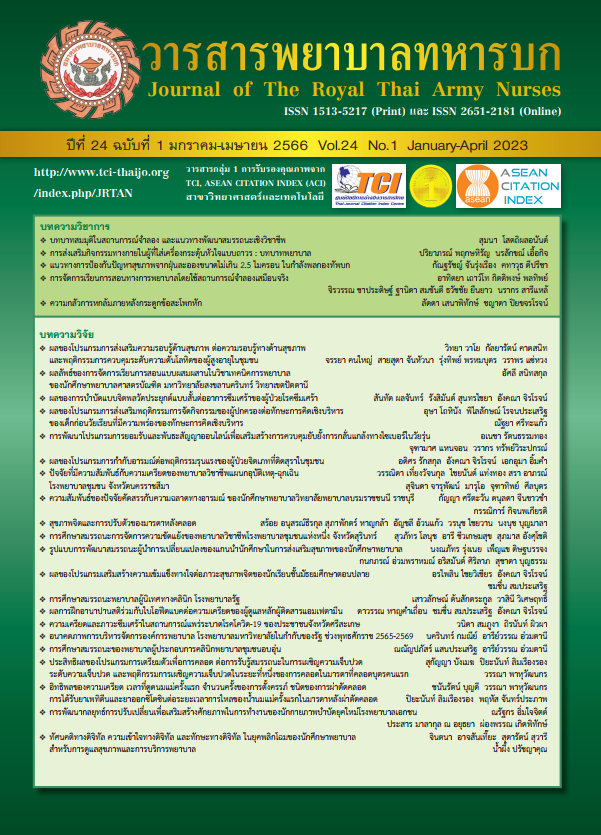Promoting Physical Activity of Persons with Permanent Cardiac Pacemaker : Nurse’s Roles
Keywords:
Physical activities, Permanent Cardiac Pacemaker, Nurse's rolesAbstract
Nowadays, the percentage of people who use permanent cardiac pacemakers is increasing. Permanent cardiac pacemaker implantation may impact their everyday lives related to physical activity limitations. According to a literature review, most of them cannot perform the same actions as previously. There are limitations in their lives, work, exercises, and decreased physical activity. As a result of this study, nurses are essential professionals who can support and promote physical activity to persons with permanent cardiac pacemakers-evaluating, estimating, and giving physical activity recommendations suited to the individual’s lifestyle to engage in enough appropriate physical activities.
Downloads
References
Kusumoto FM, Schoenfeld MH, Barrett C, Edgerton JR, Ellenbogen KA, Gold MR, et al. 2018 ACC/ AHA/HRS Guideline on the evaluation and management of patients with bradycardia and cardiac conduction delay: a report of the American college of cardiology/American heart association task force on clinical practice guidelines and the heart rhythm society. Circulation. 2019; 140(8): e382-e482.
Coombes D. Pacemaker therapy 1: clinical indications, placement and complications. Nursing Times [online]. 2021; 117(11): 22-4.
Vanessa W, Ian R, Richard K. Bradyarrhythmias. Journal of Cardiovascular Medicine. 2018; 21(9): 218-26.
Magnusson P, Liv P. Living with a pacemaker: patient-reported outcome of a pacemaker system. BMC Cardiovascular Disorders. 2018; 18(1): 110.
Asia Pacific Heart Rhythm Society. The APHRS White Book: 8thed. 2020.
World Health Organization. Global Physical Activity Questionnaire (GPAQ): analysis guide. 2016.
Wongpipit W, Kritpet T, Phongphibool S. Physical activity and Sedentary behaviour: guidelines and assessment. Journal of Sports Science and Health. 2020; 21(1): 1-21. (in Thai)
CDC. General physical activities defined by level of intensity [online]. 2020.
Ketwongsa P, Chulet P, Iamyam W, Unampai A, Sangsawang A. Handbook of physical activities at home. Nakhon Pathom: Thailand Physical Activity Knowledge Development Center [TPAK], Institute for Population and Social Research, Mahidol University. 2020. (in Thai)
Jalayondeja C, Jalayondeja W, Bovonsunthonchai S, Bunprajun T, Kaewkhuntee W. Thai physical activity guideline: Faculty of physical therapy, Mahidol University; 2015. (in Thai).
Pensri L, Ua-Kit N. Care of patients with permanent cardiac pacemaker: Nurse’s Roles. Ramathibodi Nursing Journal. 2019; 25(3): 255-69. (in Thai)
Aqeel M, Shafquat A, Salahuddin N. Pacemaker patients’ perception of unsafe activities: a survey. BMC Cardiovascular Disorders. 2008; 8(1): 31.
Pongsuay C, Choowattanapakorn T. Experiences of older persons living with permanent pacemaker. Journal of Nursing Science Chulalongkorn University. 2012; 24(3): 79-91. (in Thai)
Ghojazadeh M, Azami-Aghdash S, Sohrab-Navi Z, Kolahdouzan K. Cardiovascular patients’ experiences of living with pacemaker: qualitative study. ARYA Atheroscler. 2015; 11(5): 281-8.
Polikandrioti M, Tzirogiannis K, Zyga S, Koutelekos I, Vasilopoulos G, Theofilou P, et al. Effect of anxiety and depression on the fatigue of patients with a permanent pacemaker. Archives of medical sciences Atherosclerotic diseases. 2018; 3: e8-e17.
Aroonsang P. Nursing care for major problems of the elderly: applying. Khonkaen: Klungnanatham; 2011. (in Thai)
Bonnecaze TE, Singleton M, Bhave P. Association of atrial fibrillation and device surrogates of physical activity in patients with implanted pacemakers and defibrillators. Journal of the American College of Cardiology. 2021; 77(18_Supplement_1): 267.
Polikandrioti M, Tzirogiannis K, Zyga S, Gerogianni G, Stefanidou S, Tsami A, et al. Assessment of fatigue in patients with a permanent cardiac pacemaker: prevalence and associated factors. Archives of Medical Science Atherosclerotic Diseases. 2018; 3: e166-e73.
Haugaa KH, Potpara TS, Boveda S, Deharo J-C, Chen J, Dobreanu D, et al. Patients’ knowledge and attitudes regarding living with implantable electronic devices: results of a multicentre, multinational patient survey conducted by the European Heart Rhythm Association. EP Europace. 2018; 20(2): 386-91.
Malm D, Hallberg LRM. Patients’ experiences of daily living with a pacemaker: a grounded theory study. Journal of Health Psychology. 2006; 11(5): 787-98.
Sassone B, Mandini S, Grazzi G, Mazzoni G, Myers J, Pasanisi G. Impact of COVID-19 pandemic on physical activity in patients with implantable cardioverter-defibrillators. Journal of Cardiopulmonary Rehabilitation and Prevention. 2020; 40(5): 285-6.
Kaminsky LA, Brubaker PH, Guazzi M, Lavie CJ, Montoye AH, Sanderson BK, et al. Assessing physical activity as a core component in cardiac rehabilitation: a position statement of the American association of cardiovascular and pulmonary rehabilitation. Journal of Cardiopulmonary Rehabilitation and Prevention. 2016; 36(4): 217-29.
Goto T, Mori K, Nakasuka K, Kato M, Nakayama T, Banno T, et al. Physical activity and mortality in older patients with a pacemaker. Geriatrics & Gerontology International. 2020;20(2): 106-11.
Leal-Costa C, Lopez-Villegas A, CatalanMatamoros D , Robles - Musso E , Lappegård KT, Bautista-Mesa RJ, et al. Long-term socioeconomic impact of informal care provided to patients with pacemakers: remote vs. conventional monitoring. Healthcare. 2020; 8(2): 175.
Kramer DB, Tsai T, Natarajan P, Tewksbury E, Mitchell SL, Travison TG. Frailty, physical activity, and mobility in patients with cardiac implantable electrical devices. Journal of the American Heart Association. 2017; 6(2): e004659.
Premelč J, Hadzic V. Physical ability of patients with a pacemaker. REVIJA SPORT. 2021:58-62.
Bohplian S. Low cardiac output syndrome in cardiac surgery patient: challenging cardiovascular nurses. Journal of The Royal Thai Army Nurses. 2014; 15(2): 135-40. (in Thai)
Phramongkutklao Hospital Cardiac Rehabilitation Clinic. Patient recommendation for patients with ischemic heart disease and cardiac surgery [Document]. 2015. (in Thai)
Punkum T, Ua-Kit N. Predicting factors of health behaviors in patients with cardiac permanent pacemaker. Thai Journal of Cardio-Thoracic Nursing. 2017; 28(1): 129-41. (in Thai)
Pensri L, Ua-Kit N. The effect of education and social support program on health behaviors in patients with cardiac permanent pacemaker. Royal Thai Navy Medical Journal. 2019; 46(3): 669-83. (in Thai)
Reunthongee U., Jewpattanakul Y. Enhancing older adults’ health promotion activities by using community-based participation. Journal of The Royal Thai Army Nurses. 2022; 23(1): 274-82. (in Thai)
Downloads
Published
How to Cite
Issue
Section
License
Copyright (c) 2023 Journal of The Royal Thai Army Nurses

This work is licensed under a Creative Commons Attribution-NonCommercial-NoDerivatives 4.0 International License.
บทความหรือข้อคิดเห็นใดใดที่ปรากฏในวารสารพยาบาลทหารบกเป็นวรรณกรรมของผู้เขียน ซึ่งบรรณาธิการหรือสมาคมพยาบาลทหารบก ไม่จำเป็นต้องเห็นด้วย
บทความที่ได้รับการตีพิมพ์เป็นลิขสิทธิ์ของวารสารพยาบาลทหารบก
The ideas and opinions expressed in the Journal of The Royal Thai Army Nurses are those of the authors and not necessarily those
of the editor or Royal Thai Army Nurses Association.






